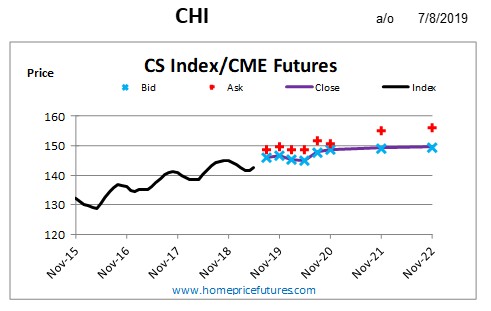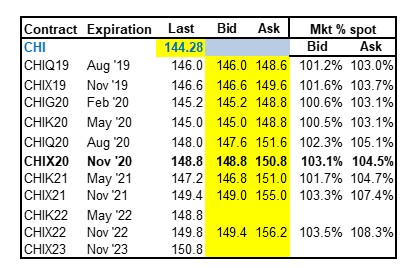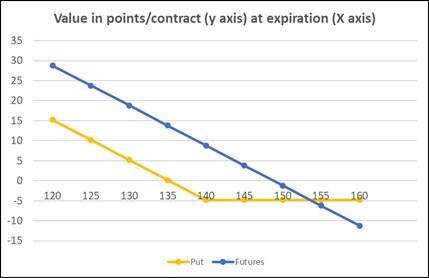John H Dolan has been the market maker for the Case Shiller futures for much of the last eight years. I often reference his work, which can be found at www.homepricefutures.com, when attempting to provide a home price forecast for the Chicago area. He wrote the following post to address the question of how the Case Shiller home price futures and options could be used to hedge home prices.
Home buyers and sellers are concerned that Chicago area home prices are trailing other cities, and that the City’s need to raise taxes may weigh on home prices. After all, Chicago home price gains have typically been the slowest across the 20 Case Shiller regions.^1
What can home buyers and sellers do? It may not be convenient to sell your home and move to a rental (and you can’t sell half your house), and many stock market hedges may only be indirectly related to home prices.
However, there are financial instruments that allow for more of a pure play on forward home prices – the Case Shiller home price index futures and options that can be traded on the Chicago Mercantile Exchange (CME).
CME contracts are structured to allow users to express a view on where a regional Case Shiller home price index will be at some point in the future. There is a contract for Chicago (CHI)^2 and there are 11 maturity dates that range (today) from Aug 2019 to Nov 2023.^3
The table below shows the current (“spot”) index of 144.82 and bids and offers on 9 of the 11 contracts. (Any of the expirations can be traded but I’m trying to focus interest on the Nov ’20 and ’22 contracts.)
To the right, I’ve converted the bid and offer prices into % over spot. For example, the bid on the CHIX20 contract (that expires in Nov 2020) is 148.8. That’s a premium of 3.1%, consistent with index values being higher than today.
A user selling (“shorting”) one contract would gain $250 for every point the index released in Nov 2020 was below 148.8. So, for example, if the index value in Nov 2020 was 144.8 (almost unchanged with today) the user would have a $1,000 profit per contract. (The economics work the same going the opposite way if index values rise above 148.8)
Note that the contracts “cash-settle” which means that the settlement value is the index value released at the end of the expiration month^4. That is, there is no obligation to unwind a position before settlement.
To trade, users need to have a futures account^5. Each contract has a notional value of $250 multiplied by the price, or about $37,000 per contract, but most brokers require an initial margin of <10%. (Note that if contract prices rise a short position will have to post more margin).
Being short futures exposes a user to the risk that prices might rise – resulting in either margin calls, or an eventual loss. For users concerned with such risks, put options may be an alternative.
Puts cap the downside in that they give the user the option to sell a futures contract at the strike price, at the expiration of the contract. The user pays an upfront fee (“premium”) for the option and that is their maximum exposure to prices increasing.
For example, in the table below, one could buy a put on the CHI contract for Nov 2020 with a strike of 140 for 4.8 points. (The 4.8 points has the same values as above: $250/point). That means that the most the put buyer could lose^6 is the 4.8 points – even if the index settles above 140. At the same time, they gain point-for-point, (in this example) with every drop in the settlement price below 140.
Differences between the two approaches (futures and options) can be illustrated in the following graph. Shorting futures will have a higher profit than puts, if index values settle lower, but a short futures position may have larger losses, if index values rise.
Between futures and options then, there are two ways (with two different risk/reward tradeoffs) to play for a decline in Chicago home prices.
Note that none of the above should be construed as investment advice. The article provides an overview of how the contracts work. Please consult your financial advisor for any advice on whether the contracts are suitable for you, and how you might use them. You can review John’s April 17th blog post, “How to get started trading CME Case Shiller futures”, or contact him if you have questions or would like to sign up for email alerts to new posts if you’d like to learn more. You can also follow him on Twitter (@HomePriceFuture).
- Case Shiller non-seasonally adjusted index
- In addition to the Chicago (CHI) contract, there are contracts for BOS, DEN, LAV, LAX, MIA, NYM, SDG, SFR, WDC and a 10-city index contract
- Note that there are many different home price indices and that they may perform differently from each other. These contracts reference the Case Shiller NSA (non-seasonally adjusted indices). Index values are updated on the last Tuesday of every month.
- Settlement is the last Tuesday of the expiration month and settlement is based on the Case Shiller index values released that day
- Interactive Brokers and Insignia Futures are two futures broker that allows trading in these contracts
- Different brokers may charge different fees. The numbers cited above do not include any additional cost of fees.
#ChicagoHomePrices #ChicagoRealEstate #CaseShiller
Gary Lucido is the President of Lucid Realty, the Chicago area’s full service real estate brokerage that offers home buyer rebates and discount commissions. If you want to keep up to date on the Chicago real estate market or get an insider’s view of the seamy underbelly of the real estate industry you can Subscribe to Getting Real by Email using the form below. Please be sure to verify your email address when you receive the verification notice.



